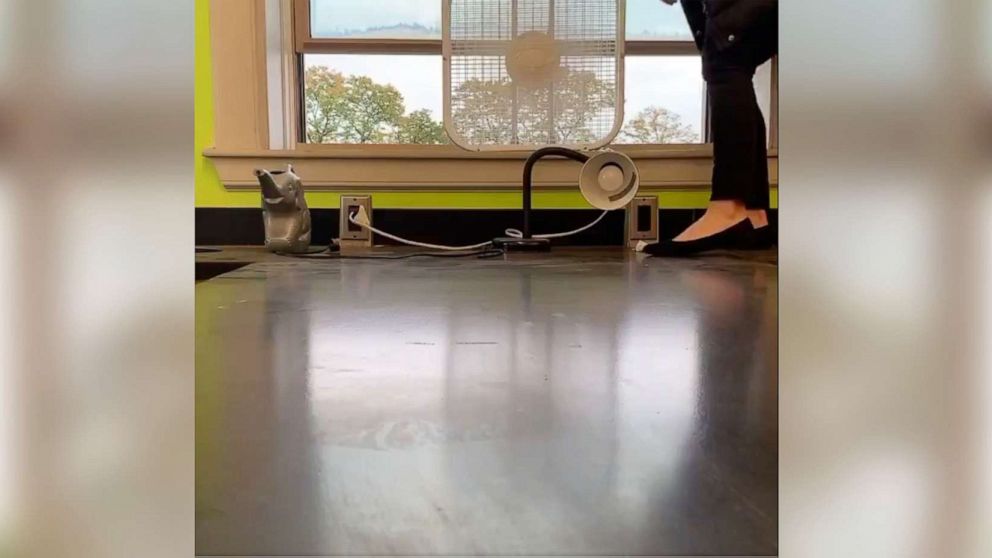


When Michelle Caine, a science teacher, returned to her classroom in a Boston public high school this fall, she shared a video of her classroom window.
The video was not to share her classroom decorations, as would be usual for teachers returning to school, but to show a fan propped up in the window, which she says school officials installed to help with ventilation amid the coronavirus pandemic.
"We expressed concerns about ventilation and the district just kept saying that they’d provided box fans and to keep the windows open," said Caine, in her fourth year of teaching. "They walked us through how many inches to keep the window open."
Caine said she believes the fan is not enough to protect herself and her students against COVID-19, and is not a usable solution in the fall and winter, when Boston hits freezing temperatures. The video Caine shared shows her standing on the window to try to close it given the cold temperatures.
She is part of a growing trend of Boston public school teachers sharing photos of their classrooms on Twitter to draw attention to the issue.
"The greater issue is these buildings and a lot of these schools have not been paid attention to and public education as a whole has been defunded year after year," said Caine. "The problems that has caused are becoming much more apparent during the pandemic."
Boston Public Schools, which oversees more than 50,000 students, started school in September on a hybrid model of remote and in-person learning. The district switched to remote learning only on Oct. 22 due to the increased COVID-19 positivity rate in Boston, a spokesperson told ABC News.
Schools in Boston, which bills itself as the "birthplace of public education" in the United States, are not the only ones facing ventilation concerns with many teachers and students back in classrooms.
MORE: Teachers DIY safety equipment for school year in the middle of coronavirus pandemicIn June, a report released by the Government Accountability Office found that about half of public schools in the United States need to update or replace building systems, including about 36,000 school buildings that need updated heating, ventilation and air conditioning systems.
The Centers for Disease Control and Prevention's guidance for safely reopening schools advises ensuring that ventilation works properly, in addition to increasing outdoor air circulation when possible, by doing things like opening windows and doors.
Since the start of the pandemic in March, the city of Boston has spent approximately $14 million on repairs, maintenance and preparation to school facilities, while BPS also provided schools with more than 6,000 fans.
"The health and safety of our students and staff remains the top priority of the Boston Public Schools (BPS)," the district told ABC News in a statement. "While our school buildings are currently closed to students and teachers, as all students districtwide are learning remotely, BPS has worked to ensure appropriate air circulation in all of our school buildings. Buildings with HVAC systems were all recently serviced, with all filters replaced and we will continue the evaluation and replacement cycle set in place. For our other school buildings, we have focused on ensuring at least one window per classroom is operable for proper ventilation, in alignment with state guidance."
"BPS is following all guidelines from the CDC, the Massachusetts Department of Elementary and Secondary Education (DESE), the Boston Public Health Commission (BPHC), and the American Society of Heating Refrigerating and Air-Conditioning Engineers (ASHRAE). BPS continues to prioritize facility improvements to ensure our buildings continue to meet public health guidelines," the statement read.
Caine claims the handful of students who returned in-person to her classroom in September, where she was required to simultaneously teach both in-person and remote, eventually returned to remote learning themselves before they were required to by the school district.
"Those ventilation and temperature issues certainly affected students’ desire to come into the building and learn," she said. "And we had a whole host of technology problems with having the students in class on Zoom, so it was pretty disastrous to put it bluntly."
Caine and other teachers say the lack of proper ventilation they see in their classrooms is just a part of a bigger problem of continually underfunded and underappreciated schools.
"We keep saying that schools are essential but we have not treated them as if they were essential until now," said Julie Fouhy, an elementary school French teacher in Boston. "Suddenly, everybody is realizing they’re essential."
Fouhy, a 20-year teaching veteran, described long days starting at 5 a.m. trying to learn online programs that teachers like herself now have access to, when she says for years they were told they were too expensive.
"I’m finding these amazing resources but each one I have to learn because now we can afford them," she said. "It gets back to the same question of, we could have it had it all before, so why just now?"
Fouhy added though that she is "optimistic" the pandemic will bring more resources to schools, saying, "I'm hoping this is a turnaround, that now we’ll think about [the fact] that kids need to go somewhere every day and be doing something very constructive and high quality."
MORE: Teacher's tearful selfie video reveals struggles of online teaching amid COVID-19Caine too said she is hopeful the difficulties of the pandemic will help bring about change.
"It is pretty infuriating that we seem to be kind of yelling into the void, but I’m glad that it’s getting some attention now, certainly," she said. "Hopefully this means we can kind of turn the corner and provide better learning conditions for kids in the future."
ABC News' Sophie Tatum contributed to this report.